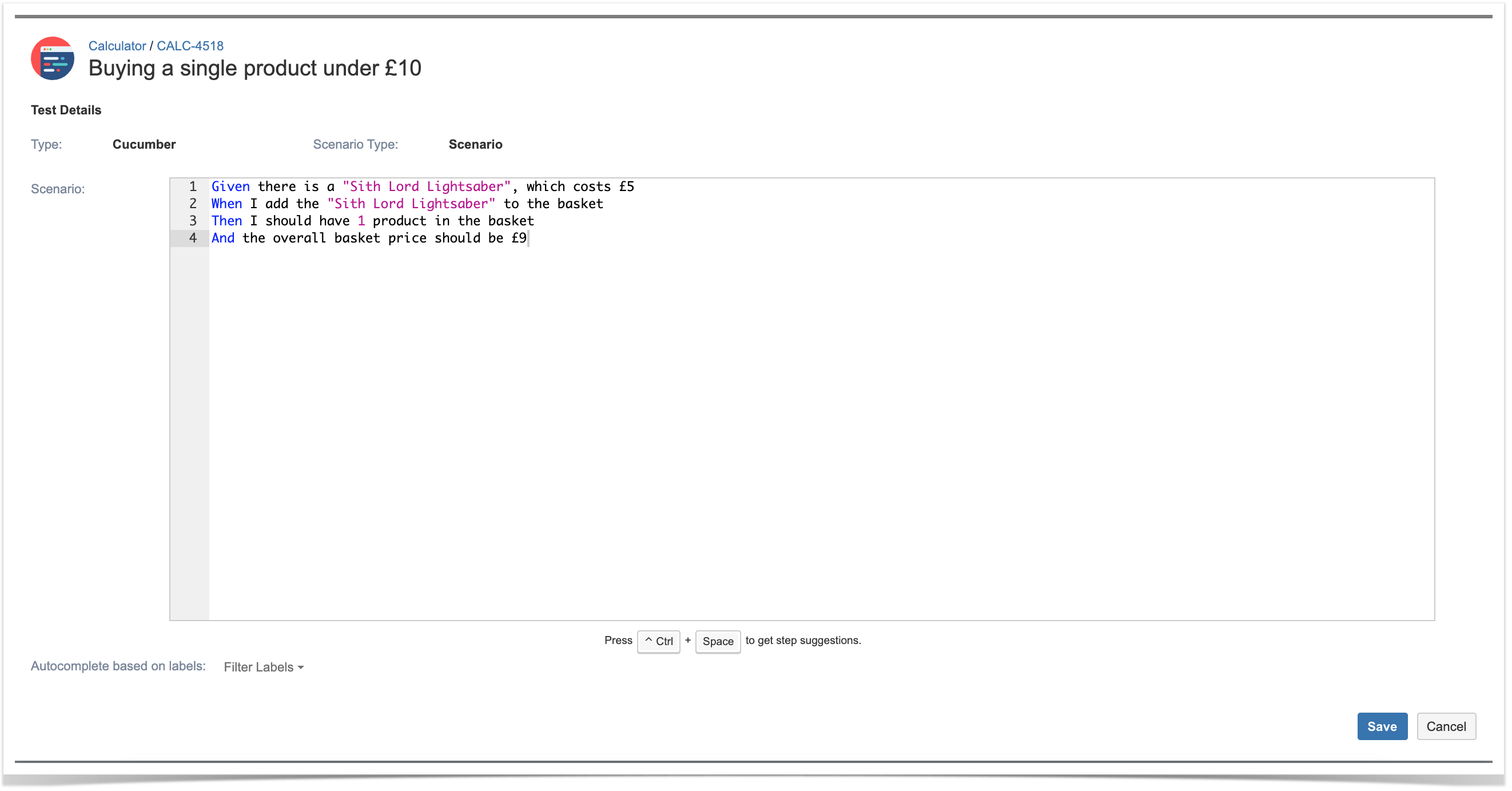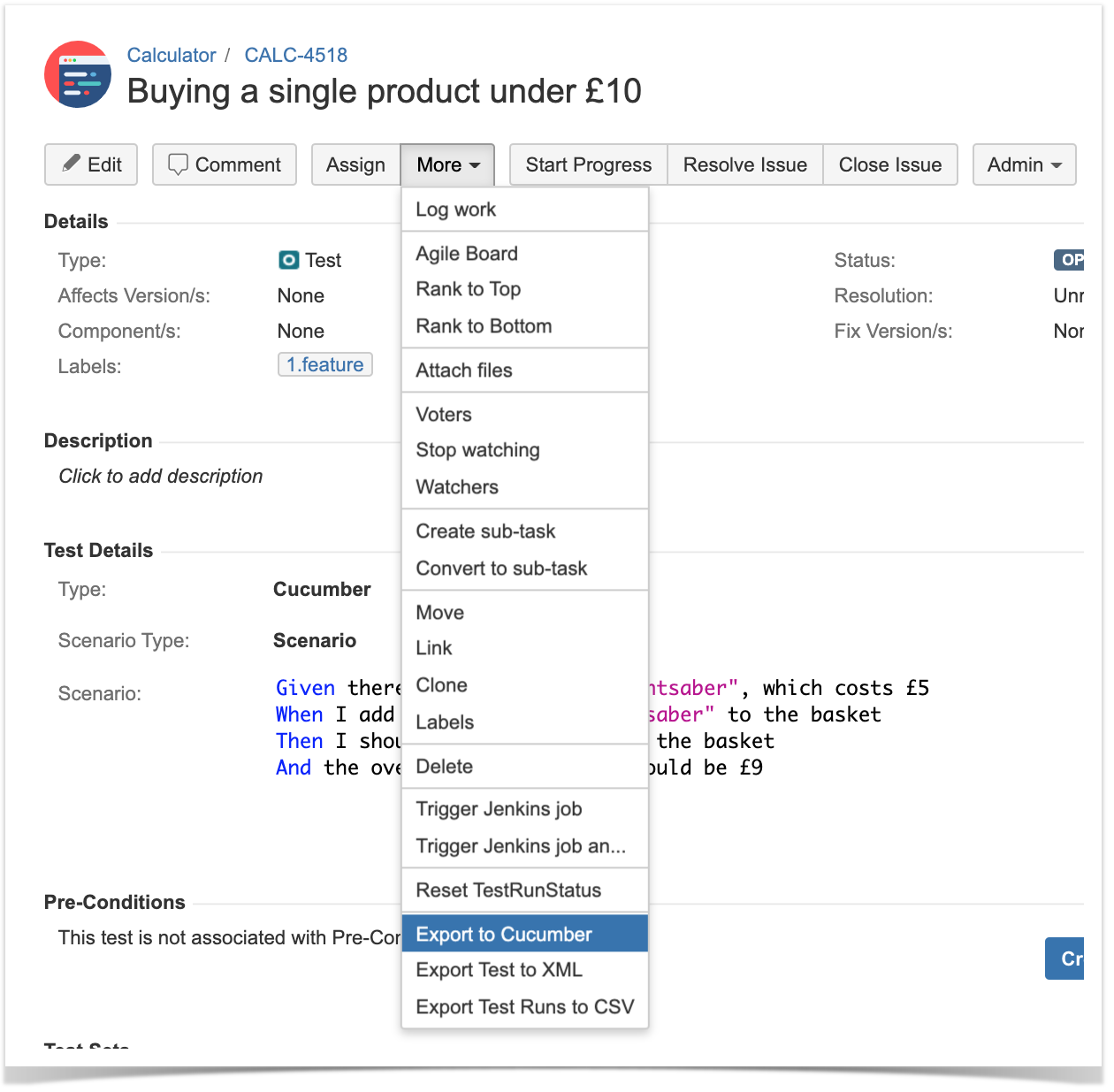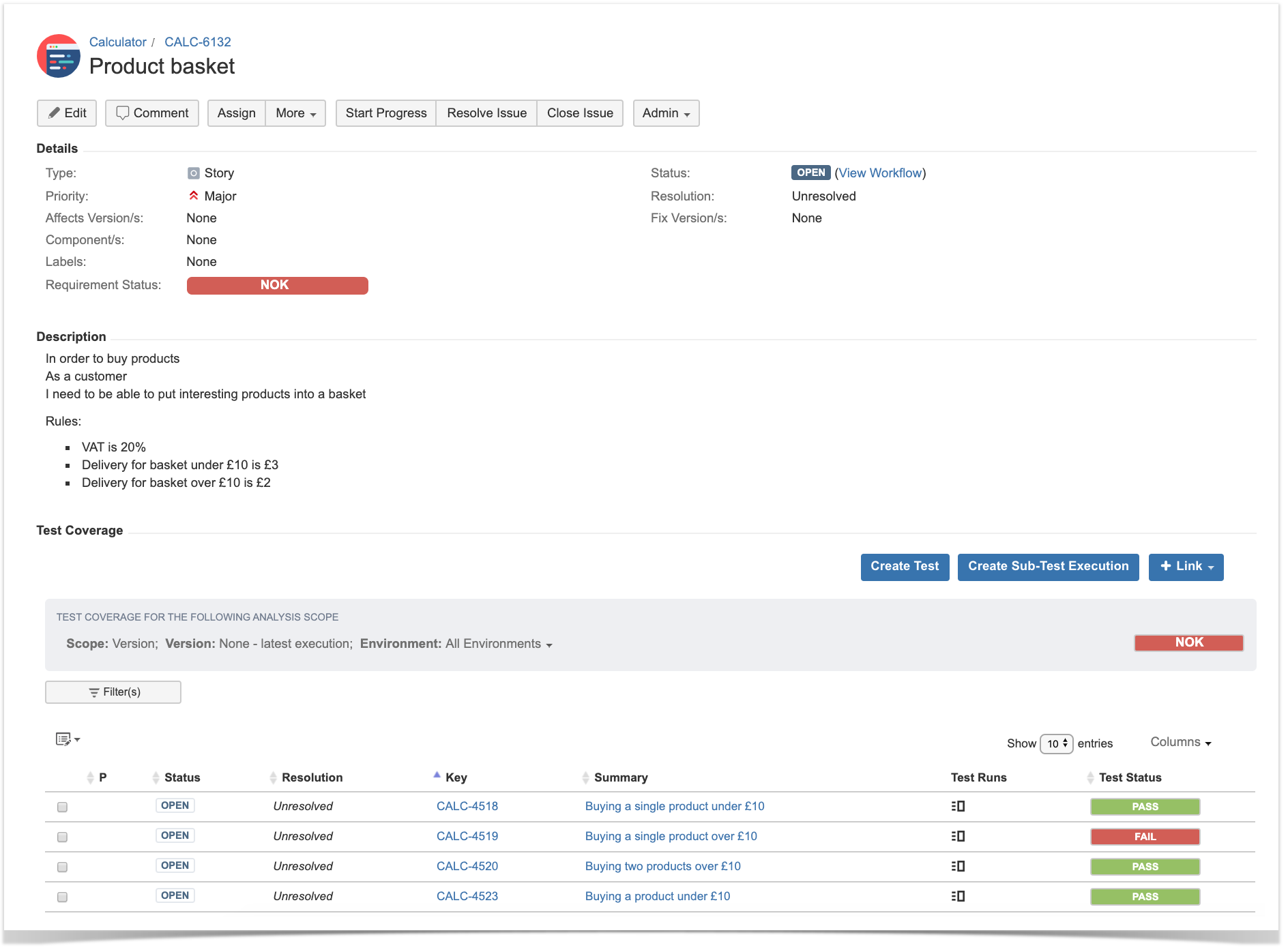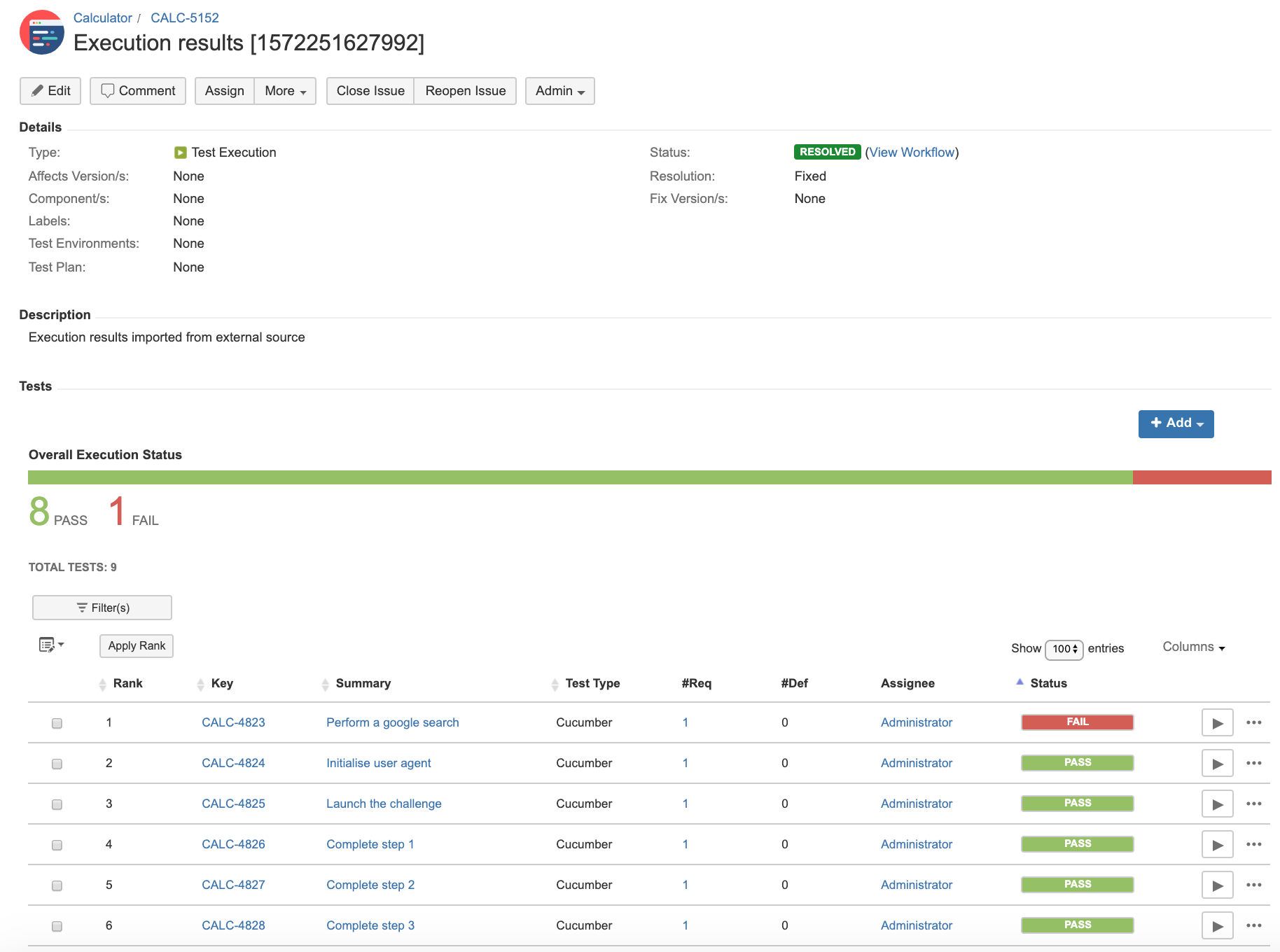Overview
In this tutorial, we will implement some Gherkin tests using Behat and PHP.
Requirements
- behat
- behat-cucumber-formatter (patched)
Description
We will use the example provided in Behat's quick start documentation, which describes a feature of a product basket.
The classes implementing our basket are quite simple and reflect the rules defined for the feature:
- VAT is 20%
- Delivery for basket under £10 is £3
- Delivery for basket over £10 is £2
We aim to use Gherkin in Behat to describe our scenarios and have an executable specification.
Remember that we need to manage:
- features (declarative specifications, usually stored in .feature files)
- corresponding automation code glue
Besides that, you'll need to decide which workflow to use:: do we want to use Xray/Jira as the master for writing the declarative specification or do we want to manage those in Git?
Learn more
Please see Testing in BDD with Gherkin based frameworks (e.g. Cucumber) for an overview of the possible workflows.
Using Jira and Xray as master
This section assumes using Xray as master, i.e. the place that you'll be using to edit the specifications (e.g. the scenarios that are part of .feature files).
The first step is to create a "Cucumber" Test (you can also use "Behat" as a valid test type, as long as it has been defined as a possible option for the Test Type custom field).
The test is quite self-explanatory, which is the ultimate purpose of using this approach: given an existing item, add it to the basket and check the basket.
After creating the Test in Jira and associating it with requirement(s), etc., you can export the specification of the test to a ".feature" file via the REST API, or the Export to Cucumber UI action from within the Test/Test Execution issue or even based on an existing saved filter. A plugin for your CI tool of choice can be used to ease this task.
The coverage and the test results can be tracked in the "requirement" side (e.g. user story).
After being exported, the created .feature file will contain the references to the Test issue key(s) and the covered requirement issue key, besides the scenario specification.
The following example shows a feature with 4 scenarios, which correspond to 4 Test issues in Xray.
@REQ_CALC-6132 Feature: Product basket #In order to buy products # As a customer # I need to be able to put interesting products into a basket # # Rules: # - VAT is 20% # - Delivery for basket under £10 is £3 # - Delivery for basket over £10 is £2 @TEST_CALC-4523 @CALC-4592 @CALC-5022 @1.feature @xpto Scenario Outline: Buying a product under £10 Given there is a "<product>", which costs £<price> When I add the "<product>" to the basket Then I should have 1 product in the basket And the overall basket price should be £<total> Examples: | product | price | total | | pen | 5 | 9 | | book | 4 | 7.8 | @TEST_CALC-4520 @CALC-4592 @CALC-5022 @1.feature Scenario: Buying two products over £10 Given there is a "Sith Lord Lightsaber", which costs £10 And there is a "Jedi Lightsaber", which costs £5 When I add the "Sith Lord Lightsaber" to the basket And I add the "Jedi Lightsaber" to the basket Then I should have 2 products in the basket And the overall basket price should be £20 @TEST_CALC-4519 @CALC-4592 @CALC-5022 @1.feature Scenario: Buying a single product over £10 Given there is a "Sith Lord Lightsaber", which costs £15 When I add the "Sith Lord Lightsaber" to the basket Then I should have 1 product in the basket And the overall basket price should be £19 @TEST_CALC-4518 @CALC-4592 @CALC-5022 @1.feature Scenario: Buying a single product under £10 Given there is a "Sith Lord Lightsaber", which costs £5 When I add the "Sith Lord Lightsaber" to the basket Then I should have 1 product in the basket And the overall basket price should be £9
The automation glue (i.e. the code corresponding to each one of these sentences - our step definitions) lives outside Jira and resides typically in some version control system, such as Git.
In this case, it is stored in a file name features/bootstrap/FeatureContext.php.
After running the tests and generating the "Cucumber" compatible JSON report (e.g., report.json), it can be imported to Xray via the REST API, or the Import Execution Results action within the Test Execution, or by using one of the available CI plugins.
vendor/bin/behat -f cucumber_json curl -H "Content-Type: application/json" -X POST -u admin:admin --data @"reports/report.json" http://jiraserver.example.com/rest/raven/1.0/import/execution/cucumber
The execution screen details will provide information on the test run result that includes step-level information including duration.
Note that the following test has a bug on purpose; in this case, the bug is not in the implementation but on the actual specification of the scenario.
As shown above, detailed error messages can be tracked per each step.
On the “requirement”/user story side (i.e the “feature”) we can also see how this result impacts the coverage; in this case, the story/feature is "NOK" because the latest result for the test "Buying a single product over 10" is FAIL.
If we wanted to correct the previous error, in this case, we would need to correct the last Gherkin step of the failing scenario and run the tests again.
Using Git or other VCS as master
You can edit your .feature and .meta files outside of Jira by storing them in your VCS using Git, for example.
In any case, you'll need to synchronize your .feature files to Jira so that you can have visibility over them and report results against them.
Thus, you need to import your .feature files to Xray/Jira; you can invoke the REST API directly or use one of the available plugins/tutorials for CI tools.
cd features rm features.zip zip -R features.zip -i \*.feature curl -H "Content-Type: multipart/form-data" -u admin:admin -F "file=@features.zip" "http://jiraserver.example.com/rest/raven/1.0/import/feature?projectKey=CALC"
Please note
Each Scenario of each .feature will be created as a Test issue that contains unique identifiers, so that if you import once again then Xray can update the existent Test and don't create any duplicated tests.
Afterward, you can export those features out of Jira based on some criteria, so they are properly tagged, run them and import back the results to the correct entities in Xray (as shown in the first scenario above).
References
- https://behat.org
- http://behat.org/en/latest/quick_start.html
- https://github.com/Vanare/behat-cucumber-formatter
- Testing in BDD with Gherkin based frameworks (e.g. Cucumber)
- https://github.com/bitcoder/cucumber-json-merge
- Automated Tests (Import/Export)
- Exporting Cucumber Tests - REST






